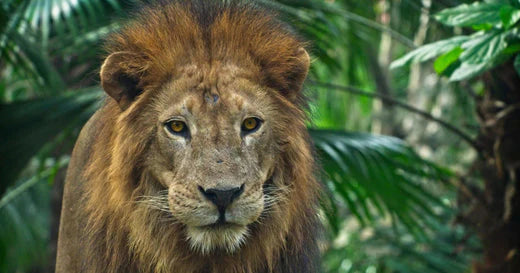The majestic beauty of lions is undeniable. They have a fierce and quiet presence when spotted resting with their pride, always on the lookout for other lions threatening to throw off their balance and take over a territory. Kids can observe them in action by watching a National Geographic documentary where their fascinating behaviors are captured through the lens of a skilled camera person. Little ones may see lions in captivity when visiting a zoo, but the real education into the behavior of these magnificent animals can only be observed in their natural habitat. Here are some intriguing facts about lions that will inspire children to learn more.

Lion Facts Kids Will Find Fascinating
Kids are naturally drawn to lions, and discovering facts about them only deepens that interest. Lions are often called the "king of the jungle," a title that brings to mind power, majesty, and leadership— qualities that kids find captivating. Learning about these incredible animals also introduces children to important ideas like ecosystems, the roles of predators and prey, conservation, and animal behavior, all in a way that's both fun and engaging. These ferocious beasts are awe-inspiring to kids who have the opportunity to see them in person, either at a zoo or on a safari. But for now, kids can appreciate their incredible strength and beauty by reading children books about lions. Here are some additional interesting facts about lions that will blow the minds of kids who are fascinated with the behavior, habitat, and survival skills of animals in the wild.
Everything to Know About Lions
Lions are often called the "king of the jungle" (even though they mostly live in savannas!). This title alone brings to mind power, majesty, and leadership, all things that appeal to kids. But it's not just their regal image; unlike most other big cats, lions live in prides. This idea of a strong family unit, where lionesses work together to hunt and raise their cubs, really resonates with children who value their own families and friendships. Continue reading to learn all about lions, including their habitats, behaviors, diets, longevity, and other interesting information.

(1) Lions are extremely social cats.
Prides typically consist of 10 to 15 members, though some have been observed with up to 30 lions. Lion prides consist mostly of females, who are responsible for hunting for food while a select few males stay back to guard the cubs and the general territory. Females stay with the pride they were born into while male lions leave to form new prides. Typically, male cubs are kicked out of their birth pride by their fathers around three years of age, at which point they head out to find another pride to take over as the alpha male.
(2) Lionesses within the same pride synchronize fertility cycles.
This way they all deliver cubs around the same time, providing an instant playgroup for their little ones. In the wild, they reproduce about once every two years, but in captivity cubs are delivered each year. Pheromones, a chemical bodies release associated with socialization, are responsible for the alignment of cycles. This is nature's way of protecting the lion population by providing a built-in network of lionesses to care for each others cubs, through nursing and protecting all offspring within a pride.
(3) Cubs need playtime to develop critical survival skills.
They practice hunting skills by stalking and wrestling with each other. The way they play together can look like fighting, but it's the way they prepare to survive on their own once it's time to leave the pride. Litters typically consist of 2 to 4 cubs that begin emulating their father a few months after birth by growling and attacking each other with playful energy.

(4) A lion's roar can be heard five miles away.
There are a lot of different reasons how and why lions roar. For instance, male lions will roar loudly to fend of predators and protect their territory. They will also show off their vocal cords to attract lionesses for mating purposes. However, when lions are hunting, they make quieter noises so as not to scare off the prey. Animal behavioralists have assessed the loudest roar at 114 decibels from a little over 3 feet, or 1 meter, away. This sound is equivalent to the noise level of a rock concert.
(5) Female lions do all of the hunting.
Males are primarily responsible for protecting the pride's territory and cubs while the females hunt for food. When they return with the meal, the dominant males assert their power by digging in first. After they have satisfied their hunger, females typically eat next, saving only scraps for the cubs. There have been instances where females help themselves first, sometimes resulting in a fight where the male ultimately gets kicked out of the pride. These occurrences, however, are few and far between.
(6) Lions are extremely fast runners.
They can reach speeds up to 50 mph. Shorter front legs and longer back legs are the perfect anatomical structure for these sprinters. Their gigantic torsos are positioned close to the ground while their hind legs propel them forward with great strength and velocity. As hunters, they are better equipped to quickly ambush their prey rather than chase them for long distances. They can also jump as far as 36 feet and can scale trees with relative ease. In doing so, they can escape unbearable heat and enjoy a nice breeze from above.
(7) Newborn lions weigh only 3 pounds.
Despite the large stature of lionesses, offspring are really small. After a gestation period of four months, the mother will give birth privately and keep her newborn shielded from the rest of the pride for about six weeks. These tiny babies are born toothless with eyes closed for the first 3 to 11 days. Fortunately, they develop at lightning fast speed, and often practice hunting by the time they are six weeks old. It is not they have reached the age of two that they are proficient hunters. And although seemingly ferocious at an early age, cubs rely on their mother's milk for the first six months.

(8) Female lions double the lifespan of males.
On average, male lions only survive for about 8 to 10 years while their female counterparts reach 15 to 16 years of age when living in the wild. Lions living in captivity such as zoos typically live for 20 years, though some can make it to the ripe old age of 30 under the care of humans. The primary cause of death for lions in the wild is an attack from other lions or prey, threats that do not exist in captivity.
(9) They are carnivores that prefer to eat larger prey.
Voracious eaters that stick to a meat-only diet, lions will feed on a variety of animals depending on what is at their disposal. In terms of hierarchy, they preference consists of a wide variety of large mammals including zebra, giraffes, wildebeest, antelope, and buffalo. When these large animals are scarce, they will consume smaller animals like rodents, mice, lizards, turtles, hares, birds, and reptiles. Farmers have to be on the lookout because lions will also feast on domestic livestock, like donkeys, horses, goats, cattle, and sheep. They are also known to steal the carcasses from other predators who did all the work. Hyenas, cheetahs, and leopards suffer an unfortunate fate when lions take a fresh kill for themselves.







